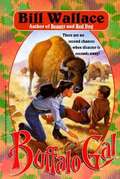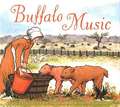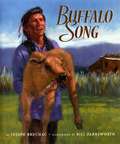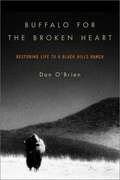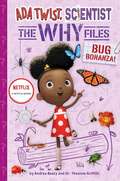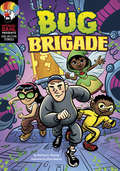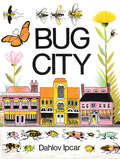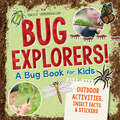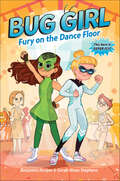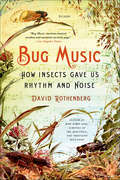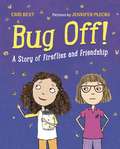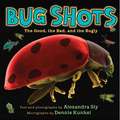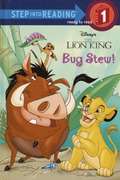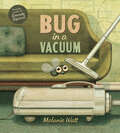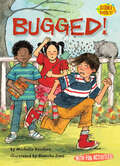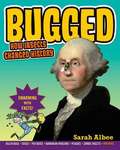- Table View
- List View
Buffalo Fluffalo and Puffalo (A Buffalo Fluffalo Story)
by Bess KalbFluffalo has had enuffalo when his quiet prairie life is turned upside down by the arrival of his new sibling, Puffalo, in this sweet and funny follow-up to the #1 New York Times bestselling Buffalo Fluffalo!Every day, Buffalo Fluffalo goes about his usual routine. He munches all the grass he can eat, frolics and rollicks with his friends, and at noontime, lies down for a nap in the shade. But one morning, Fluffalo wakes up to a loud wailing cry and, to his surprise, finds a little buffalo named Puffalo with the tiniest, shiniest eyes!At first, Fluffalo does not like Puffalo. &“What does it need?&” he huffs in alarm. But Crow wisely explains that Puffalo doesn't need much—just time to learn and grow. Slowly, Fluffalo watches as Puffalo learns to trip, slip, gallop, and trot. He teaches Puffalo to eat plants and to keep away from red ants. Together, the two take long strolls and snuggle for naps. And even though Puffalo sometimes slows him down, Fluffalo realizes that life is much better with Puffalo by his side.From national bestseller and Emmy-nominated comedy writer Bess Kalb comes this hilarious tale featuring the surly Buffalo Fluffalo and introducing his new sibling, Puffalo. Illustrated by the talented Erin Kraan, readers will delight in the loving message about the joy of discovering that the yelly, smelly, squiggly, and short new sibling might be a tiny bit cute.
Buffalo Gal
by Patricia Macdonald Bill WallaceThe bestselling author of Beauty and Snot Stew has written an exciting adventure story set in the Texas wilderness in 1904. Setting out for a trip across Texas, Amanda meets the young man who will guide them--and the two dislike each other immediately.
Buffalo Gals and Other Animal Presences
by Ursula K. Le GuinShort fiction about animals, incorporating the relationships between humans and animals in society and folklore.
Buffalo Music
by Tracey E. Fern<P>Once, long, long ago, buffalo roamed the West, filling the plains and canyons with the music of their thundering hooves and huffing breath. <P>Then hunters came and destroyed nearly all of them. <P> But buffalo are stubborn, ornery creatures, and though the herds were gone, a few lone calves lingered. <P>If the buffalo were to survive as a species, however, they needed the help of someone just as feisty as they were. <P>Inspired by the work of Mary Ann Goodnight, a pioneer credited with forming one of the first captive buffalo herds in the 1800s, this is the beautifully told and warmly illustrated tale of one woman's quest to save what otherwise would have been lost forever.
Buffalo Song
by Joseph BruchacHetcha hey Hetcha ho Hetcha hey yeh ho Walking Coyote gently lifted the frightened buffalo calf and sang softly. <P><P> Lone survivor of a herd slaughtered by white hunters, the calf was one of several buffalo orphans Walking Coyote adopted and later raised on the Flathead Indian Reservation in Montana. For thousands of years massive herds of buffalo roamed across much of North America, but by the 1870s fewer than fifteen hundred animals remained. Hunted to the brink of extinction, the buffalo were in danger of vanishing. With reverent care, Walking Coyote and his family endeavored to bring back the buffalo herds, one magnificent creature at a time. Here is the inspiring story of the first efforts to save the buffalo, an animal sacred to Native Americans and a powerful symbol of the American West. From the foresight and dedication of a few individuals such as Walking Coyote came the eventual survival of these majestic animals, one of the great success stories of endangered species rescue in United States history.
Buffalo for the Broken Heart
by Dan O'BrienFor twenty years Dan O'Brien struggled to make ends meet on his cattle ranch in South Dakota. But when a neighbor invited him to lend a hand at the annual buffalo roundup, O'Brien was inspired to convert his own ranch, the Broken Heart, to buffalo. Starting with thirteen calves, "short-necked, golden balls of wool," O'Brien embarked on a journey that returned buffalo to his land for the first time in more than a century and a half.Buffalo for the Broken Heart is at once a tender account of the buffaloes' first seasons on the ranch and an engaging lesson in wildlife ecology. Whether he's describing the grazing pattern of the buffalo, the thrill of watching a falcon home in on its prey, or the comical spectacle of a buffalo bull wallowing in the mud, O'Brien combines a novelist's eye for detail with a naturalist's understanding to create an enriching, entertaining narrative.From the Trade Paperback edition.
Buffalo for the Broken Heart: Restoring LIfe to a Black Hills Ranch
by Dan O'BrienFor twenty years Dan O'Brien struggled to make ends meet on his cattle ranch in South Dakota. But when a neighbor invited him to lend a hand at the annual buffalo roundup, O'Brien was inspired to convert his own ranch, the Broken Heart, to buffalo. Starting with thirteen calves, "short-necked, golden balls of wool," O'Brien embarked on a journey that returned buffalo to his land for the first time in more than a century and a half. Buffalo for the Broken Heart is at once a tender account of the buffaloes' first seasons on the ranch and an engaging lesson in wildlife ecology. Whether he's describing the grazing pattern of the buffalo, the thrill of watching a falcon home in on its prey, or the comical spectacle of a buffalo bull wallowing in the mud, O'Brien combines a novelist's eye for detail with a naturalist's understanding to create an enriching, entertaining narrative.
Buffalo for the Broken Heart: Restoring Life to a Black Hills Ranch
by Dan O'BrienFor twenty years, Dan O'Brien battled drought, overgrazed pastures, and falling cattle prices as he struggled to maintain his cattle ranch, The Broken Heart, nestled at the foot of South Dakota's Black Hills. Having to take stints as an endangered species biologist, English teacher, and handyman to help pay off his accumulating debts, he questioned the logic of this losing enterprise, but never lost his fierce love of the Great Plains. So when a neighboring buffalo rancher invites him to lend a hand at the annual buffalo roundup, O'Brien comes face to face with these mammoth, impressive creatures, and the seeds are planted for converting his own ranch from cattle to buffalo. Starting with thirteen calves, "short-necked, golden balls of wool," O'Brien embarks on a journey that returns buffalo to his land for the first time in more than a century and a half. In BUFFALO FOR THE BROKEN HEART, Dan O'Brien, a writer possessed of "a keen and poetic eye" (The New York Times Book Review), ranges freely under the big western sky, bringing the Great Plains to life in clear and vibrant prose. Whether he's describing the grazing pattern of the buffalo (moving quickly from one pasture to another, thereby maintaining the diversity of the grasses), the ancient thrill of watching a falcon hone in on its prey, or the comical spectacle of a buffalo bull wallowing in the mud, O'Brien brings together a novelist's eye for detail with an ecologist's understanding to create an entertaining and enriching narrative. At once a heartfelt account of his struggles at the Broken Heart, a short history of the buffalo and its near extinction, and an engaging lesson in wildlife ecology,BUFFALO FOR THE BROKEN HEART illustrates the power of a dream and how life becomes infinitely richer when we dare to follow one. This is Dan O'Brien's greatest achievement to date, placing him firmly in the canon of other great writers on nature such as Annie Dillard and Peter Matthiessen.
Buffalo: Natural History & Conservation (World Life Library)
by Harold PictonFrom the Book Jacket: In the 1800s millions of buffalo roamed the North American continent. By the beginning of the twentieth century fewer than 500 remained. For hundreds of years, the great buffalo herds had been of pivotal importance to many native peoples, who developed their cultures, communities, and ways of life around them. Yet for many settlers and soldiers, the buffalo was little more than an easy target, thoughtlessly hunted to near extinction. Since then the buffalo has become a powerful icon in North America. This book traces the natural history of the North American plains and wood bison, their origins, life cycle, and folklore about them. It also describes the successful conservation efforts in the twentieth century and the place of the buffalo in North America today. Discover the world's animals and the physical world in the WorldLife Library from Voyageur Press. This highly acclaimed series brings you the latest research from leading naturalists, along with stunning color photographs of your favorite animals and of our fascinating natural world.
Bug Band (Fountas & Pinnell Classroom, Guided Reading)
by Christy PetersonNIMAC-sourced textbook. Sound Off! Beeezzz. Chirp. Zeet. Insects make many kinds of sounds. How do they make these sounds? And what do these sounds mean?
Bug Bonanza! (Questioneers)
by Andrea Beaty Theanne GriffithBug Bonanza! is the fourth book in a nonfiction early-reader series about simple science concepts starring Ada Twist, Scientist, spun-off from Andrea Beaty’s New York Times bestselling Questioneers series and the hit Netflix show—cowritten by neuroscientist Dr. Theanne Griffith. <P><P> How do bees fly? Why does a spider weave a web? And why are bugs so important to our world? Ada Twist, Scientist: The Why Files is the perfect nonfiction resource for all these questions pondered by the youngest scientists of tomorrow, as they learn along with Ada. Designed in a scrapbook format, these books combine art from the Netflix show, illustrations, and photography to bring simple science concepts to life.
Bug Brigade (Michael Dahl Presents: Side-Splitting Stories)
by Matthew K. ManningThey're the world's greatest heroes! The grim avengers of the night! The planet's first line of defense against supervillains and alien threats! They're . . . the Bug Brigade? Doug, Josie, Kira, and Reginald were all normal sixth graders at the start of their field trip to the Blue Mountain Science Museum. Proud members of the Bug Society of Littleton, the friends are thrilled to explore a private wing of the museum where they can learn all about their favorite insects. But when they get mixed up in a scientist's experiment involving radioactive bugs, they find themselves in over their heads (and antennas!). The Bug Brigade must swarm together to fight off an evil insect villain. Will their newfound buggy superpowers be up to the test?
Bug City
by Dahlov IpcarFollow a whimsical day in the life of a Bug City family, with imaginative illustrations of real insects by American artist Dahlov IpcarThis charming bug family (Mama is a ladybug and Papa is a daddy longlegs) share a day in Bug City, where they go shopping (for calico moths and velvet ants, of course!) and visit the zoo with rhinoceros beetles and ant lions. Their quaint, busy lives, augmented by Dahlov Ipcar's flamboyant, colorful illustrations, make a charming story for readers to enjoy and learn how to identify a wide variety of bugs.
Bug Explorers! A Bug Book for Kids: Outdoor Activities and Insect Facts
by Emily GreenhalghDiscover the amazing world of bugs with a fun outdoor bug book for kids ages 3–5—with activities!Perfect for preschoolers and kindergarteners in their &“bug phase,&” this playful adventure guide pairs engaging backyard bug profiles with simple outdoor activities designed to spark wonder, build confidence, and get kids exploring in nature. Whether you&’re in the backyard, on a city sidewalk, at the park, or on a forest trail—each page turns a simple outing with your little into an exciting bug excursion. An engaging tool for budding nature enthusiasts, this book is meant to be stuffed in a backpack, brought outside, and smudged with dirt and joy. Bug Explorers! is an invitation for families to slow down, look closely, and appreciate the tiny creatures all around us. EASY OUTDOOR ACTIVITIES—screen-free prompts to encourage (safe and respectful!) observation and joyful discovery in any environment—no supplies necessary.REAL-LIFE BUG PROFILES—with vivid photos and kid-friendly science to help children recognize and understand the bugs they see in everyday life.HANDS-ON EXPLORATION—designed for real-world use, this book invites kids to develop a lifelong love of nature.
Bug Girl: Fury on the Dance Floor (Bug Girl #2)
by Sarah Hines Stephens Benjamin HarperBeing a superhero isn’t easy. But surviving a middle school dance? That’s when things get really hard…Amanda Price never dreamed she’d turn into Bug Girl, a hero with the powers of the insect kingdom. She also never dreamed it would be this difficult.Turns out superpowers aren’t much help with Geri, the new bully terrorizing the seventh grade. Or with Emily. She’s supposed to be Amanda’s partner in crime-fighting, but she’s too busy freaking out about the upcoming dance. When a mystery monster appears in town and seventh graders start disappearing, Bug Girl needs Emily's help more than ever. Soon both girls are tangled in a dastardly scheme—and the fate of their school, their town, and their very lives will be decided on the dance floor.Bug Girl: Fury on the Dance Floor is Benjamin Harper's and Sarah Hines Stephen’s buzz-worthy, hilarious superhero sequel to the original middle grade novel Bug Girl—and it’s packed with illustrations and real bug facts. An Imprint Book“Fans of Bug Girl will definitely want to fasten their mandibles on this arch sequel.” —Booklist“This entomological adventure celebrates teamwork and girl power.” —Kirkus ReviewsPraise of Bug Girl “Bearing all the campy hallmarks and high drama of a classic superhero romp, this entertaining ... tale also features interesting entomological tidbits throughout.” — Kirkus Reviews“The villain is dastardly, the heroes are staunch, and the costumes are impressive, making this high-quality standard superhero fare with the added bonus of some poignant details of how even the closest friendships may fade amid the social pressures of middle school.” — Bulletin of the Center for Children's Books“Tucks both middle-school fashion advice and insect facts into a tale that scuttles along to a wildly destructive climactic battle.” — Booklist
Bug Hotel: Independent Reading Red 2 (Reading Champion #358)
by Jackie WalterThe children at school have an exciting task today - they're making a bug hotel! The minibeasts will be very happy when the children have finished.Reading Champion offers independent reading books for children to practise and reinforce their developing reading skills.Fantastic, original stories are accompanied by engaging artwork and a reading activity. Each book has been carefully graded so that it can be matched to a child's reading ability, encouraging reading for pleasure. Perfect for the 4-5 year old beginner reader or those reading book band red.
Bug Music: How Insects Gave Us Rhythm and Noise
by David RothenbergIn the spring of 2013 the cicadas in the Northeastern United States will yet again emerge from their seventeen-year cycle—the longest gestation period of any animal. Those who experience this great sonic invasion compare their sense of wonder to the arrival of a comet or a solar eclipse. This unending rhythmic cycle is just one unique example of how the pulse and noise of insects has taught humans the meaning of rhythm, from the whirr of a cricket's wings to this unfathomable and exact seventeen-year beat. In listening to cicadas, as well as other humming, clicking, and thrumming insects, Bug Music is the first book to consider the radical notion that we humans got our idea of rhythm, synchronization, and dance from the world of insect sounds that surrounded our species over the millions of years over which we evolved. Completing the trilogy he began with Why Birds Sing and Thousand Mile Song, David Rothenberg explores a unique part of our relationship with nature and sound—the music of insects that has provided a soundtrack for humanity throughout the history of our species. Bug Music continues Rothenberg's in-depth research and spirited writing on the relationship between human and animal music, and it follows him as he explores insect influences in classical and modern music, plays his saxophone with crickets and other insects, and confers with researchers and scientists nationwide. This engaging and thought-provoking book challenges our understanding of our place in nature and our relationship to the creatures surrounding us, and makes a passionate case for the interconnectedness of species.
Bug Off!: A Story of Fireflies and Friendship
by Cari BestA young girl learns what it really means to sparkle in this charming picture book about the challenges and joys of making new friends.Lightning-bug-loving Maude wants to be a member of the Bug-of-the-Month Club in her new neighborhood, and decides that her entrance speech will be about fireflies. She reads, she researches, she prepares, and she delivers a speech that all the club members love—except for hard-to-please Louise. Louise won't even let Maude in the club! So Maude vows to really let Louise have it for being so rude. But when she does, it's not in the way anyone expects.Featuring wonderful illustrations by Jennifer Plecas, Cari Best's Bug Off! is a sparkly story about friendship, kindness, and inclusion—packed with info about fireflies, too!
Bug Out!: The World's Creepiest, Crawliest Critters (Penguin Young Readers, Level 3)
by Ginjer L. ClarkeLevel 3. This book features some of the most disgusting, far-out bugs on the planet. Learn how a scorpion uses its poison, discover how the jumping spider hunts, and more!
Bug Shots: The Good, the Bad, and the Bugly
by Alexandra Siy Dennis KunkelBugs bite, drink blood, and rob food from gardens and fields. They can even kill plants, animals, and, occasionally, people. Is bugging a crime? Alexandra Siy compiles "rap sheets" on several of the major categories of bugs and takes a very close look at some of the types of insects in an engaging text. The fascinating photo micrographs magnify insect parts from 10 to 300,000 times their actual sizes. this kid-friendly approach, coupled with meticulous research and lively writing, turns learning about insects into an intriguing experience.
Bug Stew!
by Apple Jordan Robin CuddyIn this original story based on Disney's The Lion King, ever-hungry Timon and Pumbaa entice Simba to go on a fun bug hunt. Image Descriptions Added.
Bug in a Vacuum
by Melanie WattA bug flies through an open door into a house, through a bathroom, across a kitchen and bedroom and into a living room ... where its entire life changes with the switch of a button. Sucked into the void of a vacuum bag, this one little bug moves through denial, bargaining, anger, despair and eventually acceptance -- the five stages of grief -- as it comes to terms with its fate. Will there be a light at the end of the tunnel? Will there be dust bunnies in the void? A funny, suspenseful and poignant look at the travails of a bug trapped in a vacuum.
Bug in a Vacuum
by Melanie WattA bug flies through an open door into a house, through a bathroom, across a kitchen and bedroom and into a living room ... where its entire life changes with the switch of a button. Sucked into the void of a vacuum bag, this one little bug moves through denial, bargaining, anger, despair and eventually acceptance -- the five stages of grief -- as it comes to terms with its fate. Will there be a light at the end of the tunnel? Will there be dust bunnies in the void? A funny, suspenseful and poignant look at the travails of a bug trapped in a vacuum.
Bugged! (Science Solves It!)
by Michelle KnudsenBzzzz! The mosquitoes are attacking and Riley’s on the run! Can he find a way to make himself bug-proof—once and for all?
Bugged: How Insects Changed History
by Sarah Albee Robert LeightonThere are about ten quintillion insects in the world-and some of them have affected human history in tremendous ways! For as long as humans have been on earth, we've co-existed with insects . . . for better or for worse. Once you begin to look at world history through fly-specked glasses, you begin to see the mark of these minute life forms at every turn. Beneficial bugs have built empires. Bad bugs have toppled them. Bugged is not your everyday history book. From the author and illustrator team behind kid-favorite Poop Happened! A History of the World from the Bottom Up , this combination of world history, social history, natural science, epidemiology, public health, conservation, and microbiology is told with fun and informative graphics and in an irreverent voice, making this one fun-to-read book.

